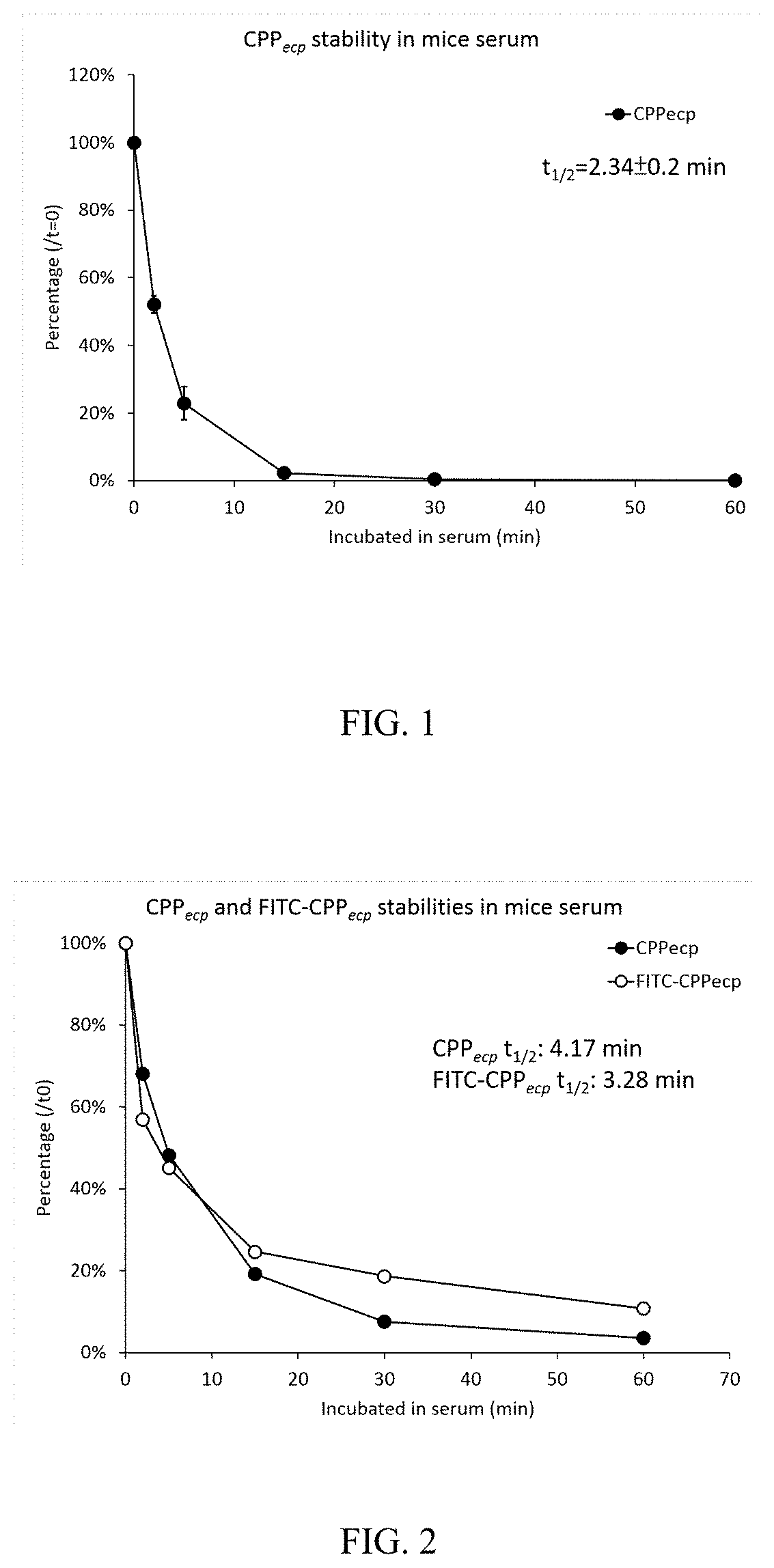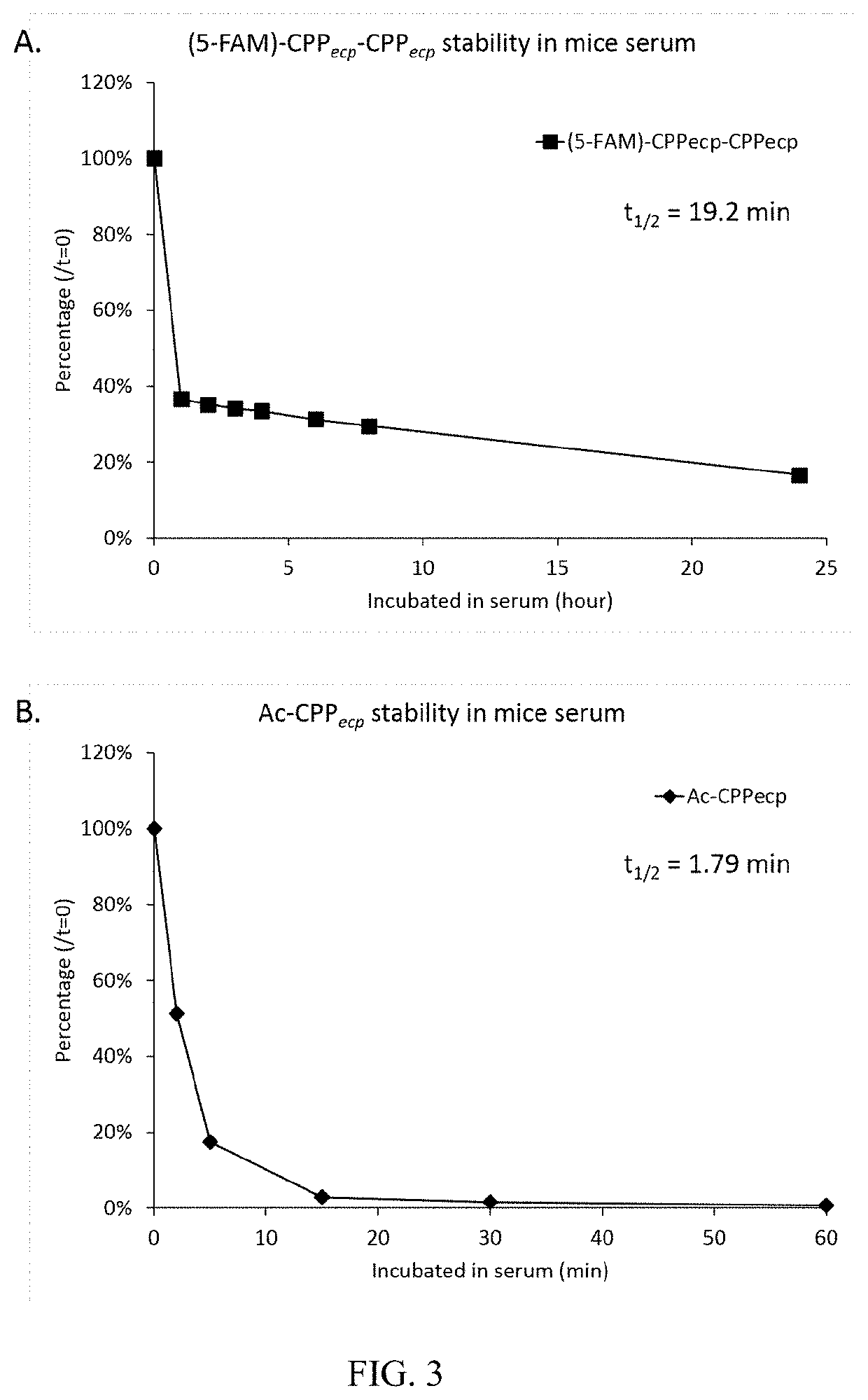Oxidative modification improves the drugability of cell penetrating peptides as drug carriers
a cell penetrating peptide and oxidative modification technology, which is applied in the direction of peptides, peptide/protein ingredients, peptide sources, etc., can solve the problems of narrow therapeutic window, unsatisfactory side effects, and compromised clinical prognosis
- Summary
- Abstract
- Description
- Claims
- Application Information
AI Technical Summary
Benefits of technology
Problems solved by technology
Method used
Image
Examples
example 1
Improvement of CPPecp Stabilities
[0029]The unmodified CPPecp (NH2-NYRWRCKNQN-COOH (SEQ. ID NO:2)) was synthesized by MISSION BIOTECH Inc. in TAIWAN. To determine the stability of unmodified CPPecp in mice serum, 100 μl of CPPecp (0.5 mg / ml or 4 mg / ml) was mixed with equal volume of whole mice serum (strain: CD-1 (ICR), final 50%) and incubated at room temperature for 0, 2, 5, 15, 30 and 60 min. The reaction was stopped by adding 200 μl of 100% TCA solution and vortexed for 5 seconds to precipitate serum proteins. Denatured serum proteins were removed by centrifugation at 18000 x g, 4° C. for 2 mins. The supernatants were analyzed by HPLC (column: Purospher® STAR RP-18e, eluent A: 0.1% TFA in dH2O, eluent B: 0.1% TFA in acetonitrile, flow rate: 1ml / min, gradient: 2-35% of eluent B in 15 min, UV wavelength: 280 nm). Zero-time point was set as one hundred percent of remaining CPPecp and relative amount of CPPecp in each time point were calculated. The t1 / 2 of CPPecp was calculated by C...
example 2
Oxidized Modification of CPPecp to Form CPPecp-dimer
[0033]In order to increase the stability of CPPecp and improve its application potential, inter-peptide disulfide bond was formed between two cysteine residues in both CPPecp peptides. For disulfide bond formation, the thiol group of cysteine in CPPecp was oxidized in the presence of any oxidizing agents, including but not limited to 10 mM H2O2 or 50 μM CuSO4, at room temperature for 12-16 hours to form CPPecp-dimer (Abouelatta, A. I., Campanali, A. A., Ekkati, A. R., Shamoun, M., Kalapugama, S., & Kodanko, J. J. (2009). Oxidation of the natural amino acids by a ferryl complex: kinetic and mechanistic studies with peptide model compounds. Inorganic chemistry, 48(16), 7729-7739.). The CPPecp-dimer was analyzed by HPLC (conditions as described in example 1) and its molecular weight was determined by commercial MASS spectrometry service (MISSION BIOTECH Inc.). For further confirming the inter-peptides disulfide bond formation, CPPecp-...
example 3
Cell Surface Binding and Penetration of CPPecp-dimer
Cell Culture
[0034]A549 cells were cultured in complete RPMI 1640 medium (Hyclone) supplemented with heated inactivated 10% (v / v) fetal bovine serum (FBS) (Gibco), and 1% (v / v) of penicillin-streptomycin (Gibco). Cells were grown on 15-mm coverslips and incubated at 37° C. in 5% CO2.
Cell Binding and Penetration of CPPecp-dimer
[0035]In order to verify if the functionality of disulfide linked dimer of CPPecp is still maintained as original CPPecp, the abilities of cell binding and penetration were investigated by FITC-conjugated CPPecp monomer and dimer, and visualized with fluorescence microscopy. Before treatment, each well and inside coverslip of 12-well plate was blocked by 2% BSA for 1 hour to prevent the non-specific binding of peptides, and washed by PBS twice. After blocking, A549 cells grown on 15-mm coverslips were incubated with 12.5 μM of FITC-CPPecp and FITC-CPPecp-dimer at 37° C. for 30 min. After wash twice in PBST, cel...
PUM
| Property | Measurement | Unit |
|---|---|---|
| UV wavelength | aaaaa | aaaaa |
| molecular weight | aaaaa | aaaaa |
| hydrophobic | aaaaa | aaaaa |
Abstract
Description
Claims
Application Information
 Login to view more
Login to view more - R&D Engineer
- R&D Manager
- IP Professional
- Industry Leading Data Capabilities
- Powerful AI technology
- Patent DNA Extraction
Browse by: Latest US Patents, China's latest patents, Technical Efficacy Thesaurus, Application Domain, Technology Topic.
© 2024 PatSnap. All rights reserved.Legal|Privacy policy|Modern Slavery Act Transparency Statement|Sitemap



